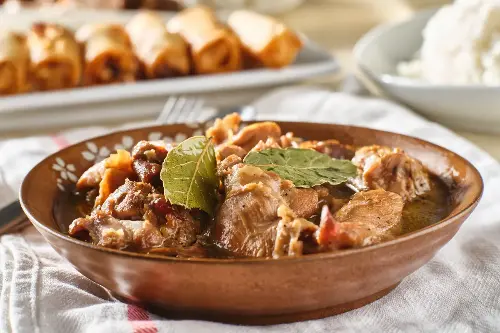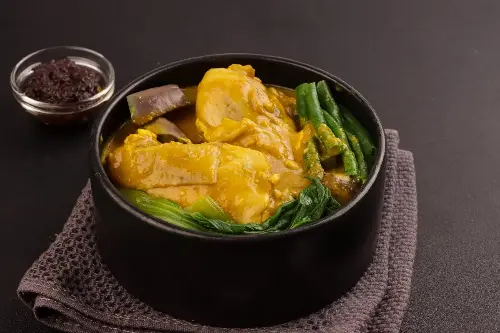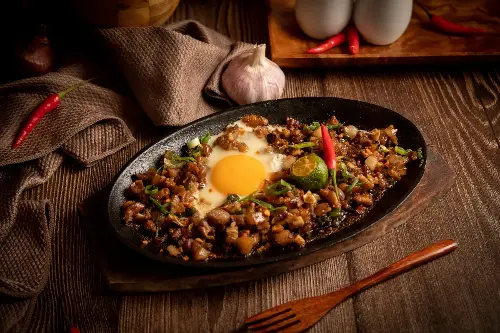The Philippines, an archipelago with over 7,000 islands, offers a diverse culinary landscape that is as vibrant and varied as its topography. Influenced by Malayo-Polynesian origins, along with Spanish, Chinese, American, and other Asian cultures, Filipino cuisine is a tantalising tapestry of flavours. For the intrepid food enthusiast, the cuisine provides a gastronomic odyssey not to be missed.
Adobo: The Quintessential Filipino Dish

No culinary journey in the Philippines would be complete without tasting Adobo. Ubiquitous and beloved across the nation, Adobo is a dish that is cooked by simmering meat, typically chicken or pork, in a marinade of soy sauce, vinegar, and garlic. The result is a rich, tangy, savoury stew that embodies the essence of Filipino comfort food. It's as variable as the islands themselves, with every family boasting their own cherished recipe.
Sinigang: A Symphony of Sourness
Another cornerstone of Filipino dining is Sinigang, a soup characterised by its sour and savoury flavours. The tangy taste comes from tamarind, calamansi, or sometimes unripe mangoes or guava. Typically, pork, shrimp, or fish are stewed with an assortment of hearty vegetables like water spinach, radish, and eggplant. Each spoonful is a burst of the Philippines—the perfect blend of zestiness and warmth.
Kare-Kare: Ode to Peanut

Kare-Kare is a rich stew vividly coloured with annatto and thickened with ground peanuts and toasted rice flour. Oxtail, tripe, and vegetables such as eggplant, banana flower, and string beans are bathed in this velvety sauce. Traditionally, Kare-Kare is served with a side of fermented shrimp paste (bagoong) that elevates the flavour palette to new heights.
Lechon: The Celebration Staple
Lechon, or roasted pig, is the undisputed star of any Filipino feast. The pig is traditionally slow-roasted over charcoal, resulting in succulent meat and crackling skin that is golden-brown perfection. Often served on important occasions, this dish is not just food; it's a centrepiece, a reason for communal celebration and shared joy.
Sisig: A Sizzling Affair

Sisig commands attention with its sizzling platter. Originating from Pampanga, the dish is a mosaic of textures and flavours made from chopped pig's head and liver, seasoned with calamansi and chillies. It's an otherworldy concoction that is crispy, spicy, tangy, and utterly mouthwatering—truly a taste sensation that has captured the stomachs of locals and visitors alike.
Seafood Galore
Given the Philippines' extensive coastline, seafood is abundantly fresh and varied. Dishes like grilled squid, fish kinilaw (raw fish in vinegar or citrus), and crabs simmered in coconut milk showcase the natural bounty of the sea. Each seafood dish brings out the essence of the ocean, served simply but with bold flavours.
Sweet Finishes

Your journey wouldn't be complete without indulging in Filipino sweets and desserts. Halo-Halo is a technicolour dream of crushed ice, evaporated milk, and a melange of sweet beans, fruit, and jelly, often topped with purple yam ice cream. Meanwhile, Leche Flan, a velvety custard with caramel sauce, is a testament to the Spanish influence on Filipino desserts and a delightful way to end any meal.
Embracing the Street Food Scene
For the truly adventurous, street food offers a glimpse into the pulse of Filipino daily life. Snack on balut (developing duck embryo), munch on crispy isaw (chicken intestines), and savour the simplicity of grilled banana known as banana cue. Street food in the Philippines is not just sustenance; it's an immersive experience of flavour and culture.
From the salty tang of Adobo to the sweet, cold rush of Halo-Halo, Filipino cuisine is a landscape of flavour waiting to be explored. The dishes mentioned here are just a starting point; there are countless regional specialties and daily culinary innovations to be discovered across the Philippines. Whether you're at a bustling Manila market or a serene seaside village, you're sure to find a warm smile ready to offer you a plate of something delicious. So, grab your fork (or better yet, your spoon and fork—the Filipino way!) and dive into the rich tapestry of taste that is Filipino food. Saan aabot ang kain mo? (Where will your hunger take you?)
